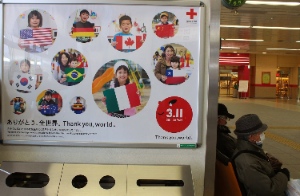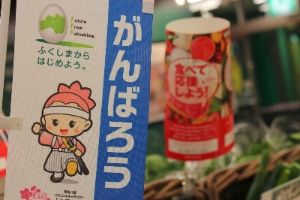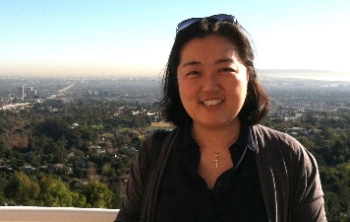
Soohwan Park is urging Vancouver Christians to support their brothers and sisters in Fukushima, Japan as they continue to rebuild their communities.
March 11 was the fourth anniversary of the Fukushima nuclear disaster in Japan. A small team of Vancouver residents is working hard to support the region’s churches as they rebuild their communities, and to martial support for them from Vancouver churches.
Soohwan Park has visited the area several times. She first visited just over a month after the worst natural disaster in Japanese history (more than 15,000 dead, hundreds of thousands displaced, widespread contamination), and then spent a year working directly with the community in 2011-2012. Below is her assessment of the disaster, its aftermath and its potential influence on Christian relief and development.
Check out Soohwan Park’s blog on Fukushima and the upcoming (May 7 – June 25) Fukushima to Vancouver Art Exhibition.
One night during the March 2011 Fukushima Daiichi nuclear meltdown, Jesus appeared to
pastor Sumiyoshi in a dream. “I saw Jesus approaching the nuclear power plant, walking toward the plant. Jesus asked me, Are you evacuating?”
In Fukushima Prefecture, the plant was severely damaged in a “cascading failure” that for weeks was out of control after the earthquake and tsunami. It became the most severe nuclear accident since Chernobyl in 1986. Nearly 20,000 people were killed, and hundreds of thousands more became homeless by nightfall.
For Sumiyoshi, Jesus’ convicting question reminded him of the questions Jesus asked of his disciples before the crucifixion about whether they would abandon him. Sumiyoshi said, “Those reminders led me to make my own decision to remain in my community.
“People were saying, ‘The nuclear power plant is very dangerous,’ or, ‘We will have another tsunami.’ I asked myself, To whose voice shall I listen? ” He said he decided to listen to God, not man. “I learned this one thing. That is the challenge to us about our own faith.”
The events of March 2011, together called Japan’s “triple disaster,” marked the most expensive catastrophe in recorded history. Losses reached more than $235 billion. Close to one million people were forced from their homes, including nearly 100,000 people who on a moment’s notice evacuated about 13 miles away from the nuclear plant. Japan, one of the strongest economic powers of the world, was brought to its knees. Leaders declared a state-level crisis for the first time since World War II.
A country of conundrums
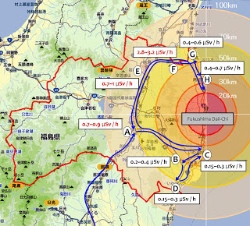 Within 24 hours of the earthquake, local churches, agencies and relief groups mobilized thousands of volunteers from more than 80 nations.
Within 24 hours of the earthquake, local churches, agencies and relief groups mobilized thousands of volunteers from more than 80 nations.
The Christian level of engagement in the disaster zone remains significant. There is no precedent for this kind of faith-based effort after natural disaster in Japan’s 2,000-year history. After his dream, Sumiyoshi and his wife decided to stay and serve their community. His small church, Nakoso Christ Church, started serving a few thousand people in a remote town overlooked by big agencies and government services. . . .
Japan is a country of conundrums to the watching world, especially in the eyes of anthropologists, missiologists, development professionals and aid agency leaders. It is one of the wealthiest nations, with a $4 trillion economy – and also has one of the highest suicide rates. It boasts high achievements in technology and science. But Shinto, the traditional Japanese religion that once defined the emperor as head of state and god, still plays a highly influential ceremonial and cultural role.
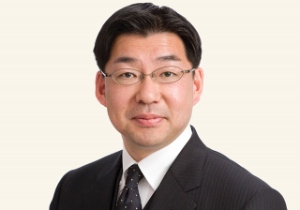
Atsuyoshi Fujiwara believes the Fukushima disaster may have ushered in Japan’s “fourth encounter with Christianity.”
Only one percent of Japanese claim Christian faith. Among Christian leaders, Japan has the stigma of being “a hard soil to plant the gospel.” That soil may have loosened since the disaster. Atsuyoshi Fujiwara, theologian and founding pastor of Tokyo’s Covenant of Grace Church, believes the events of 2011 are Japan’s “fourth encounter with Christianity.”
In the first three historic encounters, Fujiwara says, the Japanese rejected it. “Each period was different. Yet there was a pattern. Christianity came in chaotic periods when Japan lost peace and order. Initially, Japan accepted Christianity, yet gradually rejected it when it recovered peace, order, and confidence.” (See this interview with scholar Atsuyoshi Fujiwara: A Fresh Encounter with Jesus.)
Japan’s triple disaster has led Christian relief and development leaders to rethink how they do ministry in Japan. Based on my field research in Fukushima with the Marketplace Institute, a public theology think tank at Regent College in Vancouver, complex questions arose after the disaster: What do Christians uniquely bring to a materially wealthy nation struck by massive natural disasters and hostile to the growth of Christianity on its soil? What is the appropriate role of Christian relief in a time of overwhelming need?
While these questions are specific to Japan, the lessons learned are applicable to all disaster relief contexts. The Fukushima triple disaster has only heightened the need to change the practice of Christian relief and development.
From April 2011 to April 2012, Marketplace Institute convened meetings, conducted field surveys and observed relief work to explore these issues. The institute partnered with Food for the Hungry (USA and Canada), Disciple Nations Alliance (USA and Korea), and Friends with the Voiceless International (Japan).
In the field, we paid particular attention to the three neglected aspects of relief work: spirituality, story and sustainability.
Spiritual motives
For decades, disaster relief typically has been equated with physical assistance carried out
based on need and without much attention to spiritual factors.
Yet over time, the framework for relief has grown beyond physical recovery. Research on people severely disabled from accidents has verified that a spiritual perspective helps to increase victims’ resilience and recovery (findings that are explored in the 2012 book Sacred Aid: Faith and Humanitarianism).
How does a spiritual point of view inform disaster response for Christians when the religious beliefs of the majority are opposed to Christianity? In the early stage of disaster response, Marketplace Institute visited local churches and communities within a 35-mile radius of the Fukushima power plant.
Our criterion of discernment was simply this: “Pray, listen, act.” We discovered that many of those who decided to stay in the region, instead of evacuating, did so because of vivid dreams, such as pastor Sumiyoshi’s, or convictions arising from particular Bible texts.
For example, in the summer of 2011, Japanese pastors gathered for the first Fukushima Future Forum and meditated on Lamentations 3:19-23. One of many pastors who prayed aloud said, “Lord, you accept broken and humble hearts. Crush my pride and sanctify me as an instrument that can be used by you.” Before the disaster, there were about 100 churches in Fukushima. Only 20 of these, all of them with 30 or fewer members, remained on site to minister in Fukushima.
Yet dreams and convictions do not always count in the realm of disaster relief provided by paid professionals. There is no simple method to capture intangible motives, or a framework on how to measure the success or failure of actions based on a pastor’s dreams, confessions or hopes. We discovered that many relief groups don’t know how to address the spiritual dynamics of human need after a major disaster – how, for example, people cope with survivor guilt or post-traumatic stress.
Whose story counts?
Time and scale matter greatly in relief operations. They often determine how much it is going to cost to deliver results. But when relief groups focus only on metrics, saving lives is reduced to feeding the hungry, providing roofs over heads and giving water to the thirsty.
The language of organizations drives what kinds of needs count most, what type of aid has functional value and how an intervention should be delivered and its success measured.
An organization’s “story” shapes how they provide aid and how they measure results. The paradigm that drives and controls this whole process is cost-effectiveness. It is the paradigm of faster and bigger is better.
I call this the McDonaldization of human compassion: to deliver as much as possible, as fast as possible, to as many people as possible, at as low a cost as possible. (Sociologist George Ritzer, in his 1993 book, The McDonaldization of Society, claims that the fast-food industry’s goals of efficiency, calculability, predictability, and control have crept into other social sectors and dehumanized individuals.)
In the first year after the 2011 disaster, more than $5 billion in aid overwhelmed local leaders in the disaster zone. In hindsight, aid experts realized there were too many cases of mismatches between local need and available assistance, unwelcome cookie-cutter programs and a leadership vacuum.
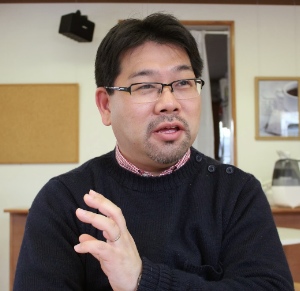
Rev. Sanga and Grace Garden Chapel in Koriyama chose to work with evacuees who were determined to reestablish themselves in Fukushima.
But there are grassroots counter-examples, and local Japanese Christians are pioneering new approaches. One is from Grace Garden Chapel in Koriyama, a midsized city 40 miles west of Fukushima Daiichi. The region’s largest shelter was located near this church.
After the first few weeks of volunteering at the shelter, church leaders decided to help a limited number of families, only the ones that they could help while maintaining personal relationships. In the selection process, they chose to help the evacuees who clearly wanted to reestablish their lives permanently.
This was an “expensive” way of providing relief assistance, but church leaders wanted to ensure that family relationships were respected and adequate personal and emotional care was provided. Throughout the whole program operation, Grace Garden stuck to one principle: Keep the motivation genuine to love neighbours, and do not use material goods to win converts.
The husband-wife pastoral team was convicted by Jeremiah 29. (The name of their church is derived from the Jewish exiles’ garden in Babylon, referenced in verses 4-5.) This scripture passage influenced how volunteers responded to the needs of survivors, physically and spiritually.
Other counter-examples come from trained volunteers who used their imagination to develop new programs: massaging the hands of elderly evacuees, foot-washings, mobile coffeehouses, safe spaces for grief counseling, restoring flood-damaged photo albums, decontaminating farmland, post-trauma camps for young children and a baseball festival. (See Beauty From Broken Things.)
The temptation to take a utilitarian approach over a people-centred one is strong, say many relief experts. But when personal, even creative, attention gets sidelined by efficiency, broken communities cannot experience full restoration or lasting change after disaster.
Sustaining hope
Rapid intervention after disaster is excellent at producing measurable, short-term results,
saving countless lives. But long-term restoration and sustainability are far more difficult.
The concept of “developmental relief” grew out development experts’ desire to set in motion lasting changes. This means setting the disaster-stricken community on the path of sustainable development.
But in Fukushima, triggered by the nuclear crisis and disaster, Christians have realized that it is not enough for development programs to try to “push the reset button” by returning the nation to where it was. Our research was driven by one question: How could relief groups help communities out of chaos and promote human flourishing, not economic pursuit and individual success?
Our research led us to Usuiso, a tiny coastal fishing village heavily damaged by the tsunami. Some 200 homes were lost, and many villagers died. Before the disaster, Usuiso was aging, economically declining, and socially inactive. After the tsunami, the only landmark of the village was a pile of radioactive debris that stood out on the flattened landscape like a mountain.
In this desolation, the leadership of one church, Global Mission Chapel, in nearby Iwaki City brought vision and hope to local survivors. While the mayor fled after the disaster, church members started serving all over the city, even though the church had also lost families.
In contrast to the slow action by Iwaki City officials, the church quickly gained the trust of the city’s remaining residents. As church members served in disaster-stricken areas, they met evacuees from Usuiso. Christian volunteers began to visit the village to pray over what remained. Church elders proposed a design for a new village with restored homes, businesses, educational and cultural facilities, and commercial centres.
In response to the disaster, Global Mission Chapel changed its name to Global Mission Center because, they said, “A church is people, not a building.” Members committed themselves to relocate to Usuiso when appropriate and to stand with villagers for generations to come. There is fresh momentum for restoring Usuiso. The members of Global Mission Center saw this vision of a new Japan rise out of their prayers with their suffering neighbors.
Where does hope arise for disaster survivors? Where does the power to restore and sustain a community and nation come from? Perhaps one secret to sustainability and lasting impact comes from a community of resilient people in a local church and the convictions they are willing to uphold at all costs.
Disaster relief is complex. Theologically, it involves restoration of all things that were broken and all relationships that are in need of reconciliation in order for a community to flourish in all areas of life (Col. 1:15-20).
Fundamentally, this is not the work of a professional agency, but of ordinary people in a local church loving their neighbours out of love for Christ. Christian relief work happens only when the local church realizes its mission to serve the world, giving themselves for others and restoring the fabric of a broken society.
Disaster relief 3.0
At the end of the yearlong process of assisting and partnering with local churches in Fukushima, we developed the idea of Disaster Relief 3.0 – Relational Relief.
In Disaster Relief 1.0, relief slowly was secularized and taken over by professional and bureaucratic leadership. In Disaster Relief 2.0, market-driven strategies and metrics further sidelined volunteer acts of charity, mercy and justice.
In Disaster Relief 3.0, the local church – not just relief experts – moves to restore itself as God’s chosen instrument for the health and charity of a community, especially before, during and after disaster. This idea is much more intensive than church-based community outreach.
It places the local church where it should be, in the community and in the midst of a crisis, and does so no matter how small it is or how great the surrounding hostility. It fosters relationships at all levels (social, economic and institutional). It creates meaningful partnerships centred on the local church in disaster-stricken communities in all stages of disaster response.
This begins by carefully listening to victims, to the quiet voice of Jesus and to one another. It also means listening to possibilities, not just immediate needs. It brings to my mind Lamentations 3:19-21, “I remember my affliction and my wandering, the bitterness and the gall. I well remember them, and my soul is downcast within me. Yet this I call to mind and therefore I have hope.”
Relational relief is a ministry of Holy Saturday – caught between the pain and suffering of death on Good Friday and the hope of resurrection on Easter Sunday.
One Sunday a few months after the triple disaster, there was a major aftershock. Sumiyoshi prayed with his congregation:
We had an earthquake this morning again. I pleaded with you, [God], not to give us any more suffering. However, we believe that everything is in your hands.
As Jesus walked toward the cross a long time ago, he is walking toward the nuclear
plant now. He is kneeling there and praying for us. Jesus made a promise that his spirit would be with each of us. We have so many sorrows, suffering, and pain in our lives. Because of the promise of Jesus, we can persevere and have hope.
This article is re-posted by permission of the author; it originally appeared in Christianity Today.
Soohwan Park will be in Fukushima again later this month, during which time she will visit the churches mentioned above. She says: “My intention and vision from God is to find some local churches in Vancouver to become long-term partners to these forgotten local churches in Fukushima. That’s part of the eight-week long prayer campaign by 10 local churches during the Fukushima to Vancouver Art Exhibition here in May/June.”


